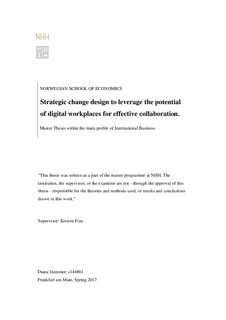Strategic change design to leverage the potential of digital workplaces for effective collaboration
Master thesis
Permanent lenke
http://hdl.handle.net/11250/2454060Utgivelsesdato
2017Metadata
Vis full innførselSamlinger
- Master Thesis [4372]
Sammendrag
During recent years, disruptive innovation in technology has driven digitalization,
globalization and mobility at increasing speed, thus transforming society and businesses alike
– a process increasingly refered to as the “Digital Transformation” by experts worldwide. The
global marketplace is becoming more competitive, requiring companies to pursue actively a
shift in paradigms towards more interconnectedness, transparency, knowledge sharing and
agility in order to succeed under a rapidly changing, increasingly complex and uncertain
environment through continuous innovation. Challenges regarding demographic change with
an aging workforce in most western countries and new expectations from the younger
employees generate additionally a war for talent, which is crucial to success due to the
increasing importance of innovation and thus the gathering of knowledge workers world wide.
This need to attract and retain skilled employees and enable increased innovation has started a
process of rethinking old work models, bringing social and community aspects into the
workplace and encouraging networking and collaboration across departments and borders
with the help of new technology. These new technology tools enabling social networks,
collaboration and knowledge-sharing practices are summarized under the broader term of
“Enterprise 2.0” technologies. Goals for the adaption of these collaboration technologies are
mainly increasing innovation and growth which require improvement in productivity and the
availability and reuse of company wide knowledge. However, despite initally high
expectations and increasing implementations of such collaboration technology in a speedy
“arms race” in the context of global digitalization as the new top competitive edge, the actual
adoption levels amongst the user community reaches from excitement to mostly indifference
to rigorous denial towards what is often perceived as “yet another platform”. Resistance to the
change implementation of those generally voluntary digital workplace is often fostered by a
lack of clear strategic goal alignment, business process application and guidelines as opposed
to other system landscape softwares such as ERP systems (e.g. SAP), thus inhibiting an
additional effort from employees to change their established behavioural habits.
This thesis looks more in detail at the underlying drivers and takes a more holistic view on the
factors influencing collaboration beyond just a new technology within the scope of a
traditional IT project. Thus, in a second step it suggests a multidimentional approach to the
successful adoption of digital collaboration technologies, touching on topics of organisational
culture, structure, leadership, business processes as well as technical incentives.
